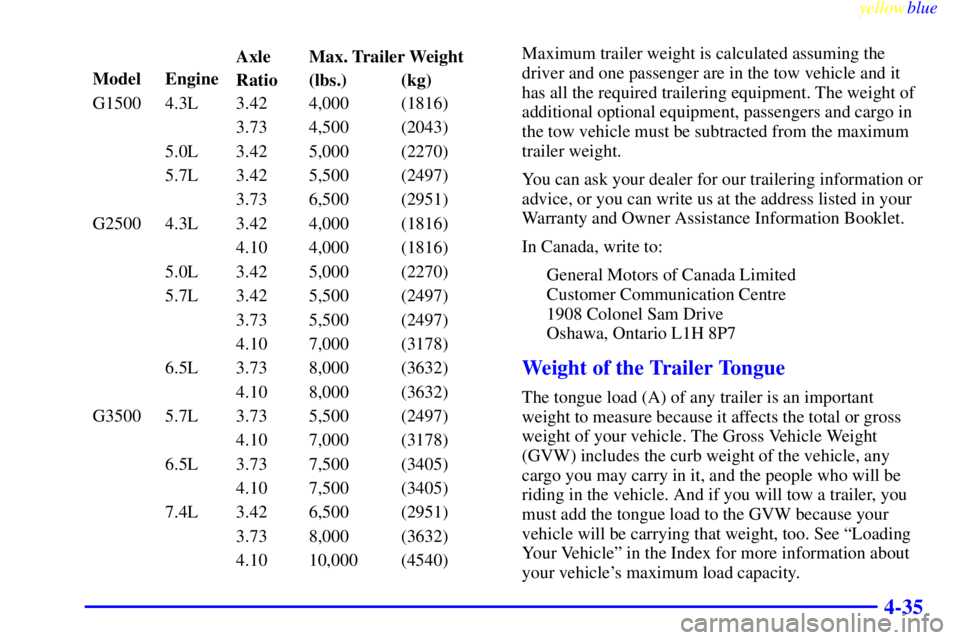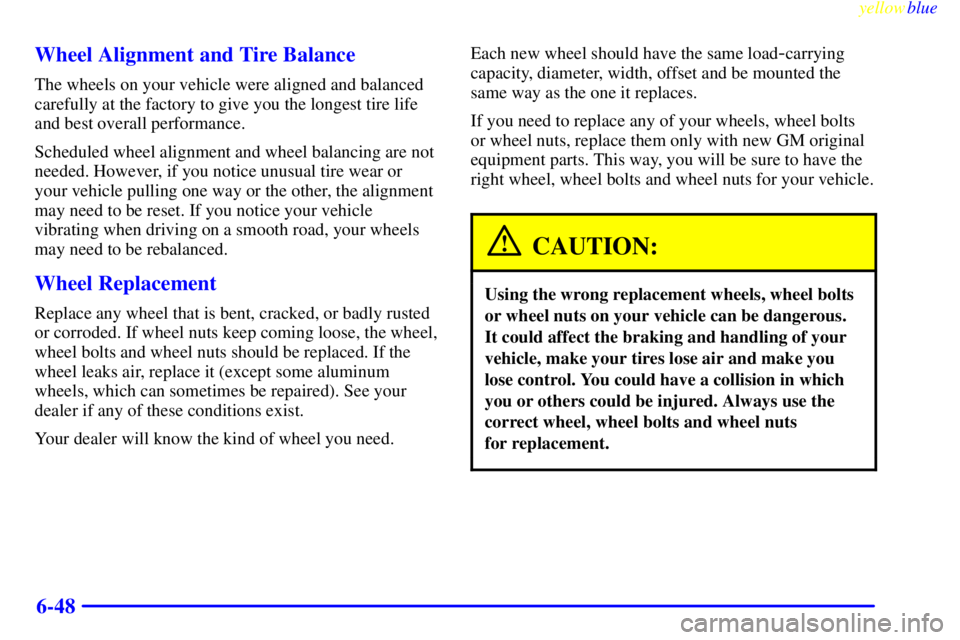Page 202 of 398

yellowblue
4-30
Loading Your VehicleThe Certification/Tire label in your vehicle will look
similar to this example.
The Certification/Tire label is found on the rear edge
of the driver's door. The label shows the size of your
original tires and the inflation pressures needed to
obtain the gross weight capacity of your vehicle.
This is called the Gross Vehicle Weight Rating
(GVWR). The GVWR includes the weight of the
vehicle, all occupants, fuel, cargo and tongue weight,
if pulling a trailer.
The Certification/Tire label also tells you the maximum
weights for the front and rear axles, called the Gross
Axle Weight Rating (GAWR). To find out the actual
loads on your front and rear axles, you need to go to a
weigh station and weigh your vehicle. Your dealer can
help you with this. Be sure to spread out your load
equally on both sides of the center line.
Never exceed the GVWR for your vehicle, or GAWR
for either the front or rear axle.
And, if you do have a heavy load, you should spread
it out.
Page 204 of 398

yellowblue
4-32 Payload
The Payload Capacity is shown on the Certification/Tire
label. This is the maximum load capacity that your
vehicle can carry. Be sure to include the weight of the
people inside as part of your load. If you added any
accessories or equipment after your vehicle left the
factory, remember to subtract the weight of these things
from the payload. Your dealer can help you with this.
Trailering Package
If your vehicle is equipped with the trailering package,
there is also a load rating which includes the weight of
the vehicle and the trailer it tows. This rating is called
the Gross Combination Weight Rating (GCWR).
When you weigh your trailer, be sure to include the
weight of everything you put in it. And, remember to
figure the weight of the people inside the vehicle as part
of your load.
Your dealer can help you determine your GCWR.
Add-On Equipment
When you carry removable items, you may need to put a
limit on how many people you carry inside your vehicle.
Be sure to weigh your vehicle before you buy and install
the new equipment.
Page 207 of 398

yellowblue
4-35
Model EngineAxle
RatioMax. Trailer Weight
(lbs.) (kg)
G1500 4.3L 3.42 4,000 (1816)
3.73 4,500 (2043)
5.0L 3.42 5,000 (2270)
5.7L 3.42 5,500 (2497)
3.73 6,500 (2951)
G2500 4.3L 3.42 4,000 (1816)
4.10 4,000 (1816)
5.0L 3.42 5,000 (2270)
5.7L 3.42 5,500 (2497)
3.73 5,500 (2497)
4.10 7,000 (3178)
6.5L 3.73 8,000 (3632)
4.10 8,000 (3632)
G3500 5.7L 3.73 5,500 (2497)
4.10 7,000 (3178)
6.5L 3.73 7,500 (3405)
4.10 7,500 (3405)
7.4L 3.42 6,500 (2951)
3.73 8,000 (3632)
4.10 10,000 (4540)Maximum trailer weight is calculated assuming the
driver and one passenger are in the tow vehicle and it
has all the required trailering equipment. The weight of
additional optional equipment, passengers and cargo in
the tow vehicle must be subtracted from the maximum
trailer weight.
You can ask your dealer for our trailering information or
advice, or you can write us at the address listed in your
Warranty and Owner Assistance Information Booklet.
In Canada, write to:
General Motors of Canada Limited
Customer Communication Centre
1908 Colonel Sam Drive
Oshawa, Ontario L1H 8P7
Weight of the Trailer Tongue
The tongue load (A) of any trailer is an important
weight to measure because it affects the total or gross
weight of your vehicle. The Gross Vehicle Weight
(GVW) includes the curb weight of the vehicle, any
cargo you may carry in it, and the people who will be
riding in the vehicle. And if you will tow a trailer, you
must add the tongue load to the GVW because your
vehicle will be carrying that weight, too. See ªLoading
Your Vehicleº in the Index for more information about
your vehicle's maximum load capacity.
Page 302 of 398

yellowblue
6-48 Wheel Alignment and Tire Balance
The wheels on your vehicle were aligned and balanced
carefully at the factory to give you the longest tire life
and best overall performance.
Scheduled wheel alignment and wheel balancing are not
needed. However, if you notice unusual tire wear or
your vehicle pulling one way or the other, the alignment
may need to be reset. If you notice your vehicle
vibrating when driving on a smooth road, your wheels
may need to be rebalanced.
Wheel Replacement
Replace any wheel that is bent, cracked, or badly rusted
or corroded. If wheel nuts keep coming loose, the wheel,
wheel bolts and wheel nuts should be replaced. If the
wheel leaks air, replace it (except some aluminum
wheels, which can sometimes be repaired). See your
dealer if any of these conditions exist.
Your dealer will know the kind of wheel you need.Each new wheel should have the same load
-carrying
capacity, diameter, width, offset and be mounted the
same way as the one it replaces.
If you need to replace any of your wheels, wheel bolts
or wheel nuts, replace them only with new GM original
equipment parts. This way, you will be sure to have the
right wheel, wheel bolts and wheel nuts for your vehicle.
CAUTION:
Using the wrong replacement wheels, wheel bolts
or wheel nuts on your vehicle can be dangerous.
It could affect the braking and handling of your
vehicle, make your tires lose air and make you
lose control. You could have a collision in which
you or others could be injured. Always use the
correct wheel, wheel bolts and wheel nuts
for replacement.